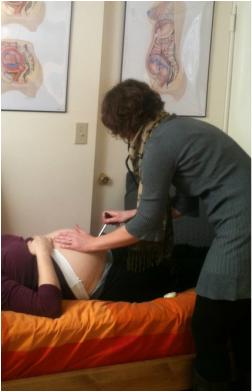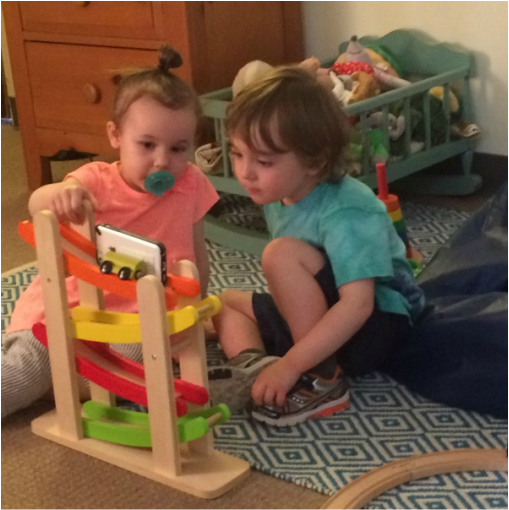|
Prenatal Care
Prenatal visits should be enjoyable, informative and thorough. I want you and your family to feel comfortable in my office. Children are welcome and can settle in a clean and cozy play area while we visit; partners and other family members are always encouraged to attend and ask questions as well. |
|

Scheduling
With the exception of home visits for your 37 week prenatal check up and the post partum check up at 24-36 hours following the birth, all appointments take place in my Columbia office and each lasts 50 minutes. We meet monthly until 32 weeks, twice a month until 36 weeks, and weekly thereafter. I may assist your birth in your home once you reach 37 weeks (36w7d) of pregnancy up until 42 weeks (41w7d). Two doctor visits In addition to your midwife's care, two physician or CNM visits are required per SC Regulations, the first of which typically falls in the first trimester after establishing care, and the other within the last 6 weeks of pregnancy. The purpose of these visits is to confirm that you are free of health problems that could possibly endanger the pregnancy or complicate a vaginal delivery. This collaborative relationship is valuable in that it allows us to consult on your behalf whenever a need arises. Tests Standard prenatal laboratory tests are collected in office. For other surveillance such as ultrasound, I refer out. Prenatal visits Good midwifery care is holistic care, which means visiting with you as a whole person. For instance, I am interested to know about your daily diet, your activity level and your emotional well-being. These are all areas that contribute to the health of your pregnancy and the well-being of your baby. Again, I like to remind you that prenatal care is mainly what you do between prenatal visits. The clinical portion of your prenatal check-ups may include a urine analysis, weight and blood pressure checks, measurement of your baby's growth (belly measurement) and always a listen to his or her heartbeat. In the 3rd trimester we also palpate your belly to determine baby's position, presentation, etc. During the course of pregnancy you will be offered information on tests and treatments that are considered standard in maternity and newborn care. Before you accept or decline a certain test or treatment, I do ask that you thoroughly research the available information and ask questions so you can make responsible, informed choices and decisions for yourself and for your baby. Childbirth preparation classes I very strongly encourage all first time parents, as well as those who have not previously had a natural birth experience, to participate in a childbirth preparation class that is not taught in a hospital. New parents who have attended classes together have shown to be better prepared for birth. Labor and Birth Who's coming to my birth? Your primary birth team will consist of myself and an assistant who is either another licensed midwife or a licensed midwife apprentice. We bring our doula skills to each birth as well, but if you so desire you may certainly arrange for a private doula to be present also. For guaranteed lovely pictures we suggest you hire a professional photographer, and lastly, a wise midwife once coined the phrase: birth is a celebration, not a party.. Meaning: you are free to surround yourself with the people who are important to you in labor, but less is more, and the rule is that nobody gets to invite themselves ! Did you know that only five percent of mothers spontaneously go into labor on their due date? This means that even two babies with nicely spaced due dates may choose the same day to be born. To be prepared for these rare situations we have back-up agreements between practices. We understand the importance of having only familiar faces at your birth, so during extremely busy times and whenever possible we will facilitate a meeting between client and all potential team members prior to the birth. There is NO extra cost to you in the event that a back-up midwife is called to attend your birth. The BIG DAY By the time the first changes begin to occur, you will have learned from your prenatal visits what signs to look for and how to make yourself comfortable in early labor. Evenso, you'll be in touch with me by phone regularly throughout this phase. Once we have established that you are in active labor, or anytime you ask for support, we will come to your home. I will encourage you to find your own way through your labor journey, and also carefully monitor your and baby's well being at certain intervals in the most unobtrusive way possible. For siblings who are present during the birth, I ask that an adult be designated to look after their needs, so that parents can stay involved in the birth while the children can participate at their comfort level or are in a different location. After delivery I stay for several hours to make sure you and baby are stable and breastfeeding is off to a good start. Mother and baby are never separated. The newborn exam will be done surrounded by the family. You will also be instructed on what to expect post partum, what is normal and what's not, and to report to us often in the first 24 hours until we return to your home for another check-up the next day, and more often as needed. Your midwife team comes prepared to handle emergencies: we carry oxygen, resuscitation equipment and may administer certain medications to the mother after the birth of the baby in case of abnormal bleeding. We are trained and up-to-date in CPR and Neonatal Resuscitation. Post partum care The day after birth, between 24-36 hrs, I return to your home to check on you and your baby. I will collect the Newborn Metabolic Screen (heel stick) the results of which will be sent to your baby's doctor in about one week. I also perform the CCHD screening (Critical Congenital Heart Defects screening) at this visit, which is quick and painless (read here Emerson Rose Foundation for information about this test). Both tests are mandated by SC State law. I will file the birth certificate paperwork for you and explain how to obtain your copy. Additional visits such as weight-checks may be conducted in your home or my office. At six weeks we see each other one last time for a complete check-up and to say our good-byes. Afterbirth While growing your baby, your body also grows the placenta. This amazing organ sustains your baby in the womb and it is born shortly after his/her arrival, hence the name "afterbirth". Before disposing of it, we inspect it carefully and if you like, we will share this "exam" with you. Once this is done you get to decide its fate: discard it, save it for burial and perhaps planting a special shrub or tree on top, or consume it as a supplement (placenta encapsulation). |
